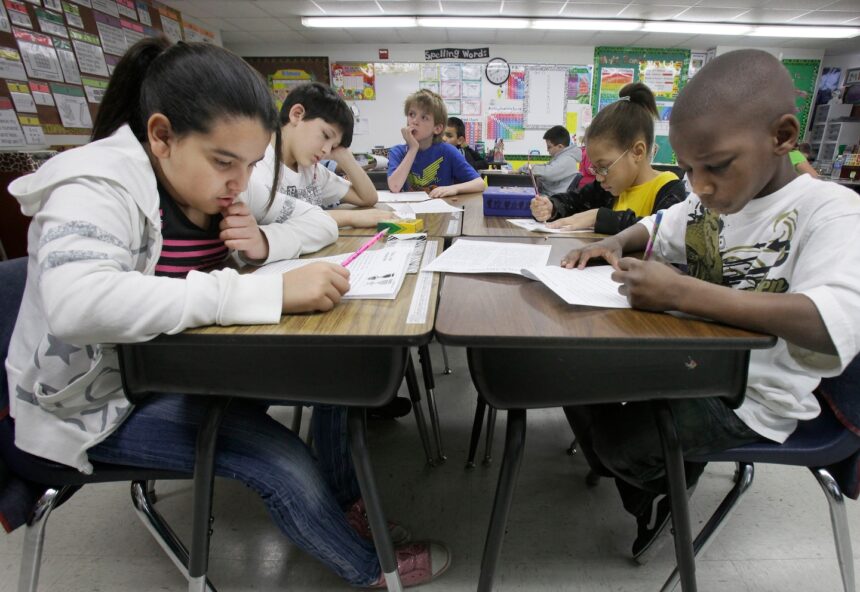Worries about the separation of church and state in the Texas curriculum were previously reported by the 74, an education news website, when the materials were released last week. The state is also considering about 145 other curriculums from 25 vendors. Changes wouldn’t enter classrooms until at least August 2025.
The TEA wrote the lessons after a piece of state legislation, House Bill 1605, required the agency to create a curriculum that will be free to school districts pending state education board approval. One of the stated reasons for the bill was so teachers wouldn’t have to spend precious time searching for materials or end up with subpar information, said Shannon Trejo, TEA’s deputy commissioner of school programs.
Texas Education Commissioner Mike Morath denied that the lessons push Christian beliefs.
“There is content, where relevant, that provides information on various religious traditions,” Morath wrote to The Washington Post. “For example, as students learn about Ancient Greece, they will also learn about the religion of the Greeks. Students will learn about aspects of most major world religions. Content does not include religious lessons as one would find in a religious school, and instead is designed to provide background knowledge and vocabulary to ensure our students can reach high levels of academic proficiency and comprehend great literature.”
Opponents agree it would be malpractice to not mention religion in school instruction, but they are worried about the amount and methods of including religion.
“It’s hard to understand or to teach Western civilization or European history without understanding the impact or the influence religion had on Martin Luther and his treatise and Martin Luther King Jr.,” said Zeph Capo, president of the Texas American Federation of Teachers. “But there’s a difference between providing context of the circumstances and actually injecting stories and fables and religious indoctrination into the curriculum.”
The union, which disapproves of the curriculum, represents 66,000 nonadministrative school employees across Texas. Of those, he said, about 70 percent are teachers.
‘One religion above all’
The idea of Austin handing down a curriculum with religious context to teachers seems hypocritical to Capo, who taught middle school science and social studies, considering the recent right-wing hysteria around teachers indoctrinating students in the classroom.
Capo said the state starved school districts for money to the point that they have to adopt this curriculum because districts get $60 per student to offset the costs.
“You’ve created a funding shortage for school districts and then thrown them this carrot,” he said.
Despite the rise of inflation, Texas legislators have not given teachers a significant raise in about five years, said Jaime Puente, director of economic opportunity with the nonpartisan tax policy group Every Texan.
The new curriculum gives a chance for some districts to replace their books that could be five or 10 years old with new materials at a defrayed cost.
“It’s not like there’s much of a choice,” he said.
Many view the new curriculum as part of a ploy by Republican state leaders to hollow public schools and eventually privatize education.
Religious conservatives, validated by victories in the Supreme Court and state legislatures, have eroded what were once constitutional prohibitions against spending tax money directly on religious education, The Post has reported.
Experts said the fact that billions in taxpayer dollars subsidize religious school tuition throughout the country via state voucher programs shows that the line between church and state is deteriorating. The vast majority of vouchers are used at religious schools, according to a Washington Post examination of the nation’s largest voucher programs, and are most popular in GOP-led states.
The largest conservative state without a voucher program? Texas.
But that may change. After failing to do so in 2023, Republican Gov. Greg Abbott said he had the votes to pass his voucher program.
“The Governor thinks he has the cards to win that hand,” Puente said.
The next step toward implementing the curriculum proposal is for the Texas State Board of Education to review and approve material, including a meeting in September to accept public feedback and a vote in November. Schools are scheduled to start using whatever is approved in August 2025.
Few people have gone through the more than 100,000 pages of the 3,300 lessons. There are lessons about the 11th-century satirist-poet Kshemendra and the Crusades against Jews and Muslims, but it is clear the materials include many religious references that center Christianity.
“I would love to give the TEA the benefit of the doubt for wanting to include study of religion at all points of the curriculum when it naturally fits in,” said Mark Chancey, who has read many of the reading lessons.
Chancey is a Southern Methodist University religious studies professor who studies the forces that put the Bible in public schools. He said teaching religion for the sake of cultural literacy and civic life is important because the nation was founded on religious freedom. He said it would be just as dangerous to not teach about religion, including Christianity.
“With that being said,” Chancey said, “it is very hard to separate the pronounced Christian emphasis in these materials from the Texas Republican Party’s complete embrace of Christian nationalism.”
Days before the curriculum was released, the Texas GOP approved a platform saying it urges “the Legislature and the State Board of Education to require instruction on the Bible, servant leadership, and Christian self-governance.” It added that it supported “guidance from a traditional biblical perspective based on Judeo-Christian principles with the informed consent of a parent” from a chaplain.
“We have to pay attention to the context in which this is happening,” Chancey said. “For that reason, it’s hard to avoid the unfortunate conclusion that some of these lessons seem designed to promote Religious conservatives, validated by victories in the Supreme Court and state legislatures.”
After the curriculum was released, Abbott thanked the TEA, adding: “The materials will also allow our students to better understand the connection of history, art, community, literature, and religion on pivotal events.”
Chancey and others agree that teaching about the Bible helps students better understand literature. Those who push for a separation of church and state know that it’s hard to interpret most English-language literature without an understanding of some Bible stories — including David and Goliath, King Solomon and the baby and the Tower of Babel.
The Texas curriculum works best when it is followed, Trejo said, because it builds upon its previous lessons from grade to grade. Students learn in kindergarten about the Bible, a TEA official said, so they can better understand when the Rev. Martin Luther King Jr. in his letter from the Birmingham jail mentions the refusal of Shadrach, Meshach and Abednego to obey the laws of Nebuchadnezzar as a way to teach civil disobedience.
That idea of knowledge-based instruction is emblematic of a larger fight in public education that began in the late 1980s and early 1990s when E.D. Hirsch published his book “Cultural Literacy,” which demanded that students be taught a list of 5,000 names and dates and concepts every American should know.
But Hirsch’s list proved to be incomplete the day the book was released: He was asked before a room of education writers why the book didn’t include Cinco de Mayo. He said he didn’t know what that was.
Still, the idea of “core knowledge” remains in the mainstream three decades later and was the basis for the proposed Texas curriculum that is causing concern.
“There is very much a debate in the curriculum and instruction world about what makes up these foundational texts that everyone should be familiar with,” said Rhianna Thomas, an assistant professor of early-childhood education at New Mexico State University.
If the list isn’t updated as the nation becomes more diverse, “the mission of that approach is to maintain a Eurocentric approach in the curriculum.”
She said some of the lessons were getting close to Sunday school instruction a student would see in a church.
“They see their teacher as a role model,” Thomas said. “So if they learn their teacher promotes a certain religion, that really affects how they see their own religion or their family’s traditions.”
Zhihui Fang, a researcher who teaches early-childhood education at the University of Florida, reviewed a kindergarten lesson from the Texas curriculum.
The lesson has the instructor teaching the 5-year-olds about the Golden Rule and centers the entire idea of treating others the way you wish to be treated on religion. The lesson begins by having the teacher explain that two versions come from the Bible. First, the lesson introduces the Bible without much context.
“Several books of the Christian Bible describe a man who lived a long, long time ago — nearly 2,000 years ago — in a part of the world that is very far from here. The man was named Jesus.”
The lesson then goes on to detail how Jesus gave his Sermon on the Mount. The mention of the Jewish version of the rules says God told “a man named Moses.” The lesson also says Hinduism and Islam have the rule but offer no more details.
Fang said he has seen Christianity mentioned to students but “not as explicitly as this.”
“Curriculum is always a political animal,” Fang said. “Whoever has the power gets to decide what gets to get included.”











